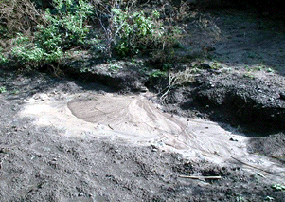Fluvial deposition
If the friction force decreases deposition of the transported load starts. At these locations the load is deposited in different forms such as gravel cone (see figure).
These processes taking place in rivers form - likewise the processes on slopes – the watersheds like the Gina River catchment. A large part of work is done during flood events. During these events the most and largest particles can be eroded and transported by the water – and much destructed. Watershed Management is a suitable approach in order to protect infrastructure, agricultural and settlement areas, etc. by systematic measures against flood damages. The measures are not solely directed to the lower reaches where the discharge, in general, is higher, but also to the headwater areas where the floods develop. Also, in WM solutions for upstream-downstream resource users can be solved, if, for example, the upstream users retain the river water in a dam.
Since many centuries human attempts to take a corrective action into these river processes in the context of Water Management (see development of watershed management approach). However, in view of climate change as well as intensified and not appropriated land use methods such extreme events may cumulate (Förch and Schütt 2004 b; Schönwiese 2003). How sensible a landscape may response to such external effects is topic of the next chapter.
 But before starting with this you can answer the test questions of this chapter.
But before starting with this you can answer the test questions of this chapter.
 The references of this chapter you can see if you follow the text or image hyperlink.
The references of this chapter you can see if you follow the text or image hyperlink.
